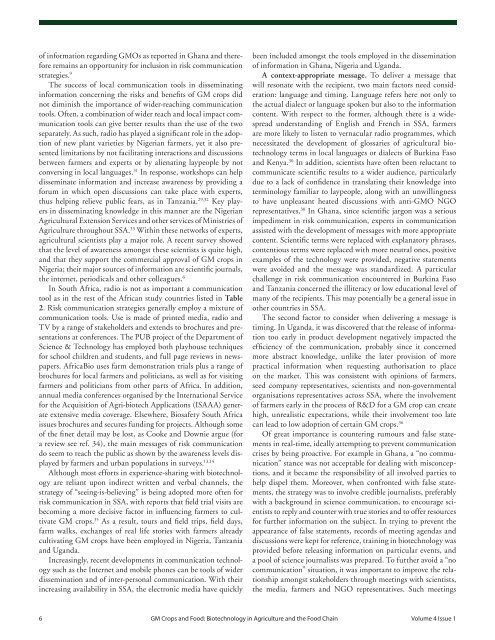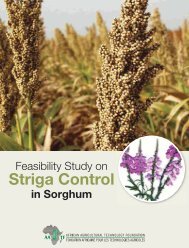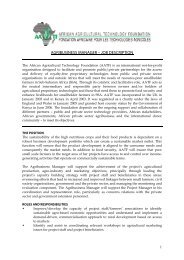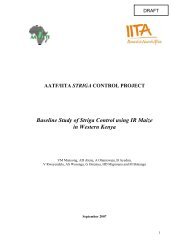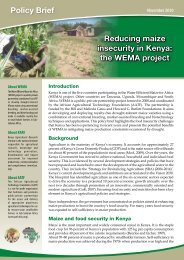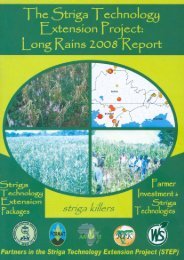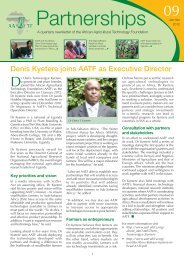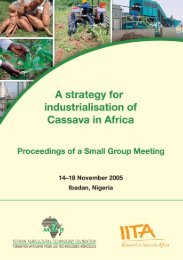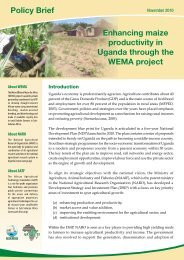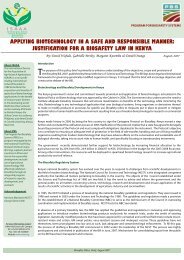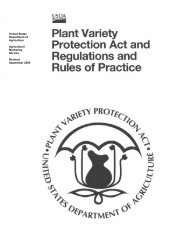Experiences in sub-Saharan Africa with GM crop risk communication
Experiences in sub-Saharan Africa with GM crop risk communication
Experiences in sub-Saharan Africa with GM crop risk communication
You also want an ePaper? Increase the reach of your titles
YUMPU automatically turns print PDFs into web optimized ePapers that Google loves.
of <strong>in</strong>formation regard<strong>in</strong>g <strong>GM</strong>Os as reported <strong>in</strong> Ghana and therefore<br />
rema<strong>in</strong>s an opportunity for <strong>in</strong>clusion <strong>in</strong> <strong>risk</strong> <strong>communication</strong><br />
strategies. 9<br />
The success of local <strong>communication</strong> tools <strong>in</strong> dissem<strong>in</strong>at<strong>in</strong>g<br />
<strong>in</strong>formation concern<strong>in</strong>g the <strong>risk</strong>s and benefits of <strong>GM</strong> <strong>crop</strong>s did<br />
not dim<strong>in</strong>ish the importance of wider-reach<strong>in</strong>g <strong>communication</strong><br />
tools. Often, a comb<strong>in</strong>ation of wider reach and local impact <strong>communication</strong><br />
tools can give better results than the use of the two<br />
separately. As such, radio has played a significant role <strong>in</strong> the adoption<br />
of new plant varieties by Nigerian farmers, yet it also presented<br />
limitations by not facilitat<strong>in</strong>g <strong>in</strong>teractions and discussions<br />
between farmers and experts or by alienat<strong>in</strong>g laypeople by not<br />
convers<strong>in</strong>g <strong>in</strong> local languages. 31 In response, workshops can help<br />
dissem<strong>in</strong>ate <strong>in</strong>formation and <strong>in</strong>crease awareness by provid<strong>in</strong>g a<br />
forum <strong>in</strong> which open discussions can take place <strong>with</strong> experts,<br />
thus help<strong>in</strong>g relieve public fears, as <strong>in</strong> Tanzania. 29,32 Key players<br />
<strong>in</strong> dissem<strong>in</strong>at<strong>in</strong>g knowledge <strong>in</strong> this manner are the Nigerian<br />
Agricultural Extension Services and other services of M<strong>in</strong>istries of<br />
Agriculture throughout SSA. 33 With<strong>in</strong> these networks of experts,<br />
agricultural scientists play a major role. A recent survey showed<br />
that the level of awareness amongst these scientists is quite high,<br />
and that they support the commercial approval of <strong>GM</strong> <strong>crop</strong>s <strong>in</strong><br />
Nigeria; their major sources of <strong>in</strong>formation are scientific journals,<br />
the <strong>in</strong>ternet, periodicals and other colleagues. 6<br />
In South <strong>Africa</strong>, radio is not as important a <strong>communication</strong><br />
tool as <strong>in</strong> the rest of the <strong>Africa</strong>n study countries listed <strong>in</strong> Table<br />
2. Risk <strong>communication</strong> strategies generally employ a mixture of<br />
<strong>communication</strong> tools. Use is made of pr<strong>in</strong>ted media, radio and<br />
TV by a range of stakeholders and extends to brochures and presentations<br />
at conferences. The PUB project of the Department of<br />
Science & Technology has employed both playhouse techniques<br />
for school children and students, and full page reviews <strong>in</strong> newspapers.<br />
<strong>Africa</strong>Bio uses farm demonstration trials plus a range of<br />
brochures for local farmers and politicians, as well as for visit<strong>in</strong>g<br />
farmers and politicians from other parts of <strong>Africa</strong>. In addition,<br />
annual media conferences organised by the International Service<br />
for the Acquisition of Agri-biotech Applications (ISAAA) generate<br />
extensive media coverage. Elsewhere, Biosafety South <strong>Africa</strong><br />
issues brochures and secures fund<strong>in</strong>g for projects. Although some<br />
of the f<strong>in</strong>er detail may be lost, as Cooke and Downie argue (for<br />
a review see ref. 34), the ma<strong>in</strong> messages of <strong>risk</strong> <strong>communication</strong><br />
do seem to reach the public as shown by the awareness levels displayed<br />
by farmers and urban populations <strong>in</strong> surveys. 13,14<br />
Although most efforts <strong>in</strong> experience-shar<strong>in</strong>g <strong>with</strong> biotechnology<br />
are reliant upon <strong>in</strong>direct written and verbal channels, the<br />
strategy of “see<strong>in</strong>g-is-believ<strong>in</strong>g” is be<strong>in</strong>g adopted more often for<br />
<strong>risk</strong> <strong>communication</strong> <strong>in</strong> SSA, <strong>with</strong> reports that field trial visits are<br />
becom<strong>in</strong>g a more decisive factor <strong>in</strong> <strong>in</strong>fluenc<strong>in</strong>g farmers to cultivate<br />
<strong>GM</strong> <strong>crop</strong>s. 35 As a result, tours and field trips, field days,<br />
farm walks, exchanges of real life stories <strong>with</strong> farmers already<br />
cultivat<strong>in</strong>g <strong>GM</strong> <strong>crop</strong>s have been employed <strong>in</strong> Nigeria, Tanzania<br />
and Uganda.<br />
Increas<strong>in</strong>gly, recent developments <strong>in</strong> <strong>communication</strong> technology<br />
such as the Internet and mobile phones can be tools of wider<br />
dissem<strong>in</strong>ation and of <strong>in</strong>ter-personal <strong>communication</strong>. With their<br />
<strong>in</strong>creas<strong>in</strong>g availability <strong>in</strong> SSA, the electronic media have quickly<br />
been <strong>in</strong>cluded amongst the tools employed <strong>in</strong> the dissem<strong>in</strong>ation<br />
of <strong>in</strong>formation <strong>in</strong> Ghana, Nigeria and Uganda.<br />
A context-appropriate message. To deliver a message that<br />
will resonate <strong>with</strong> the recipient, two ma<strong>in</strong> factors need consideration:<br />
language and tim<strong>in</strong>g. Language refers here not only to<br />
the actual dialect or language spoken but also to the <strong>in</strong>formation<br />
content. With respect to the former, although there is a widespread<br />
understand<strong>in</strong>g of English and French <strong>in</strong> SSA, farmers<br />
are more likely to listen to vernacular radio programmes, which<br />
necessitated the development of glossaries of agricultural biotechnology<br />
terms <strong>in</strong> local languages or dialects of Burk<strong>in</strong>a Faso<br />
and Kenya. 30 In addition, scientists have often been reluctant to<br />
communicate scientific results to a wider audience, particularly<br />
due to a lack of confidence <strong>in</strong> translat<strong>in</strong>g their knowledge <strong>in</strong>to<br />
term<strong>in</strong>ology familiar to laypeople, along <strong>with</strong> an unwill<strong>in</strong>gness<br />
to have unpleasant heated discussions <strong>with</strong> anti-<strong>GM</strong>O NGO<br />
representatives. 30 In Ghana, s<strong>in</strong>ce scientific jargon was a serious<br />
impediment <strong>in</strong> <strong>risk</strong> <strong>communication</strong>, experts <strong>in</strong> <strong>communication</strong><br />
assisted <strong>with</strong> the development of messages <strong>with</strong> more appropriate<br />
content. Scientific terms were replaced <strong>with</strong> explanatory phrases,<br />
contentious terms were replaced <strong>with</strong> more neutral ones, positive<br />
examples of the technology were provided, negative statements<br />
were avoided and the message was standardized. A particular<br />
challenge <strong>in</strong> <strong>risk</strong> <strong>communication</strong> encountered <strong>in</strong> Burk<strong>in</strong>a Faso<br />
and Tanzania concerned the illiteracy or low educational level of<br />
many of the recipients. This may potentially be a general issue <strong>in</strong><br />
other countries <strong>in</strong> SSA.<br />
The second factor to consider when deliver<strong>in</strong>g a message is<br />
tim<strong>in</strong>g. In Uganda, it was discovered that the release of <strong>in</strong>formation<br />
too early <strong>in</strong> product development negatively impacted the<br />
efficiency of the <strong>communication</strong>, probably s<strong>in</strong>ce it concerned<br />
more abstract knowledge, unlike the later provision of more<br />
practical <strong>in</strong>formation when request<strong>in</strong>g authorisation to place<br />
on the market. This was consistent <strong>with</strong> op<strong>in</strong>ions of farmers,<br />
seed company representatives, scientists and non-governmental<br />
organisations representatives across SSA, where the <strong>in</strong>volvement<br />
of farmers early <strong>in</strong> the process of R&D for a <strong>GM</strong> <strong>crop</strong> can create<br />
high, unrealistic expectations, while their <strong>in</strong>volvement too late<br />
can lead to low adoption of certa<strong>in</strong> <strong>GM</strong> <strong>crop</strong>s. 36<br />
Of great importance is counter<strong>in</strong>g rumours and false statements<br />
<strong>in</strong> real-time, ideally attempt<strong>in</strong>g to prevent <strong>communication</strong><br />
crises by be<strong>in</strong>g proactive. For example <strong>in</strong> Ghana, a “no <strong>communication</strong>”<br />
stance was not acceptable for deal<strong>in</strong>g <strong>with</strong> misconceptions,<br />
and it became the responsibility of all <strong>in</strong>volved parties to<br />
help dispel them. Moreover, when confronted <strong>with</strong> false statements,<br />
the strategy was to <strong>in</strong>volve credible journalists, preferably<br />
<strong>with</strong> a background <strong>in</strong> science <strong>communication</strong>, to encourage scientists<br />
to reply and counter <strong>with</strong> true stories and to offer resources<br />
for further <strong>in</strong>formation on the <strong>sub</strong>ject. In try<strong>in</strong>g to prevent the<br />
appearance of false statements, records of meet<strong>in</strong>g agendas and<br />
discussions were kept for reference, tra<strong>in</strong><strong>in</strong>g <strong>in</strong> biotechnology was<br />
provided before releas<strong>in</strong>g <strong>in</strong>formation on particular events, and<br />
a pool of science journalists was prepared. To further avoid a “no<br />
<strong>communication</strong>” situation, it was important to improve the relationship<br />
amongst stakeholders through meet<strong>in</strong>gs <strong>with</strong> scientists,<br />
the media, farmers and NGO representatives. Such meet<strong>in</strong>gs<br />
6 <strong>GM</strong> Crops and Food: Biotechnology <strong>in</strong> Agriculture and the Food Cha<strong>in</strong> Volume 4 Issue 1


